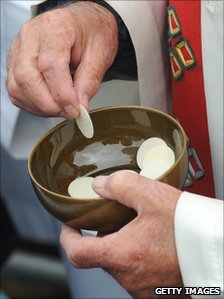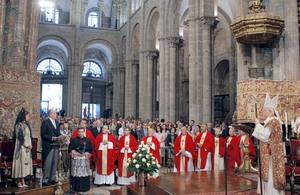 Catholics today are choosing cremation over the burial of the body. The numbers are on the increase in recent years due to economic reasons, perceived ecological concerns space limitations in some places. But are these good reasons to chose cremation of the body? The Church’s allowance of cremation is given by exception with a strong preference for the entombment of the body (either in the ground or a masoleum). Why? Principally because cremation does not fully express a Christian’s belief in the Resurrection of the body on the Last Day.
Catholics today are choosing cremation over the burial of the body. The numbers are on the increase in recent years due to economic reasons, perceived ecological concerns space limitations in some places. But are these good reasons to chose cremation of the body? The Church’s allowance of cremation is given by exception with a strong preference for the entombment of the body (either in the ground or a masoleum). Why? Principally because cremation does not fully express a Christian’s belief in the Resurrection of the body on the Last Day.
ENDOW: a new Feminism Catholic style
 ENDOW (Educating on the Nature & Dignity of Women) is a Catholic educational program bringing women together to discover what it means to be a woman, made in God’s image and likeness holding a God-given dignity known in being a person. ENDOW is a new feminism promoting the beauty of being a woman.
ENDOW (Educating on the Nature & Dignity of Women) is a Catholic educational program bringing women together to discover what it means to be a woman, made in God’s image and likeness holding a God-given dignity known in being a person. ENDOW is a new feminism promoting the beauty of being a woman.
Is our love enlarged enough to trust the other?
The work of holiness is supposedly on our lists of things “to do.” Yet, we bounce from thing to thing, place to place, guru to guru without considering the true source of holiness and how holiness develops. Yes, it is a work but it is not something imposed on us by an external force. As St Gregory of Nyssa once said, “For the quality of holiness is shown not by what we say but by what we do in life.” No gift can be imposed on someone, neither from God nor from another. We can never take a gift but only be open to receiving a gift. This is particularly true in meeting God and a friend.
us is so low, why our attachments are so poor, our view of life so dim, our
belief so unreal, our general notions so artificial and external is this, that
we dare not trust each other with the secret of our hearts. We have each the
same secret, and we keep it to ourselves, and we fear that, as a cause of
estrangement, which really would be a bond of union. We do not probe the wounds
of our nature thoroughly: we do not lay the foundation of our religious
profession in the ground of our inner man: we make clean the outside of things:
we are amiable and friendly to each other in words and deeds, but our love is
not enlarged, our bowels of affection are straightened, and we fear to let
intercourse begin at the root: and in consequence, our religion viewed as a
social system is hollow, the presence of Christ is not in it. (Plain and
Parochial Sermons, V, pp. 126-7).
The priest is a fighting man
Preaching the first Mass of a newly ordained member of his monastic community, Benedictine Father Ambrose Bennett cited “Emmanuel Cardinal Suhard, who served as Archbishop of Paris
in the post-war years, expressed this mystery [of the priesthood] very eloquently in a beautiful
pastoral letter that he wrote to his priest on Holy Thursday of 1949:
At the altar, the priest, like
Christ, is the [sacrificial] victim. But he is also the sacrificer; he is then
the dreadful man, the one who works death, the one who slays sin and burns it,
the one who is crucified and who crucifies, the one who cannot save the world,
nor will consent to its salvation, save through nailing it to the Cross.
“Without the shedding of blood there is no redemption” (Heb. 9.22)… That is why
the priest in relation to society must always be somehow or other its
adversary. He will never be forgiven for recalling and perpetuating, from
generation to generation, Christ, whom they thought they had suppressed
forever… Far from being a fatherly adviser or a good-natured citizen, a priest
is, like God, a terrible being. He is a fighting man… Like Saint Michael, he
challenges the Dragon, dragging him out of ambush by healing men’s hearts, so
as to crush one by one his ever resurgent heads. Although it is too frequently
overlooked, a priest is an exorcist…; he has the power and the duty of
expelling the Devil (Cardinal Suhard, Priests Among Men, pp. 82-83; 44-45).
Church of Canada priestess gives communion to a dog
 AND you wonder why fewer and fewer people take the Anglican Church (or the Episcopal Church if you are American) with a degree of seriousness. Recently a Church of Canada priestess gave communion to a German Shepherd as a “simple church act of reaching out.” What a gesture of welcome! This act is not only contravening “church policy” as much as it is an acknowledgement that the real Presence of Christ is not a Reality for these people. Policy is has nothing to do with it, does it? But if the Anglicans of the Church of Canada simply believe Communion is a symbol or that it represents something else…. Sounds like Joseph Campbell, Derida and many Protestant theologians (e.g. Borg, Tillich and Bultmann) are patron saints of mere symbol and not of Jesus Christ, body and blood, soul and divinity.
AND you wonder why fewer and fewer people take the Anglican Church (or the Episcopal Church if you are American) with a degree of seriousness. Recently a Church of Canada priestess gave communion to a German Shepherd as a “simple church act of reaching out.” What a gesture of welcome! This act is not only contravening “church policy” as much as it is an acknowledgement that the real Presence of Christ is not a Reality for these people. Policy is has nothing to do with it, does it? But if the Anglicans of the Church of Canada simply believe Communion is a symbol or that it represents something else…. Sounds like Joseph Campbell, Derida and many Protestant theologians (e.g. Borg, Tillich and Bultmann) are patron saints of mere symbol and not of Jesus Christ, body and blood, soul and divinity.
Nuns land record deal
 The Benedictine nuns of the French abbey of Our Lady of the Annunciation of Le Barroux (near the famed Avignon) landed a music contract with Universal Music. This is the same label as Lady Gaga and Elton John.
The Benedictine nuns of the French abbey of Our Lady of the Annunciation of Le Barroux (near the famed Avignon) landed a music contract with Universal Music. This is the same label as Lady Gaga and Elton John.
Father Lawrence Boadt, CSP, RIP
 Paulist Father Larry Boadt, 67, died Saturday after a long illness.
Paulist Father Larry Boadt, 67, died Saturday after a long illness.
Saint James the Greater (Santiago)
 Almighty Father, by the martyrdom of Saint James You blessed the work of the early Church. May his profession of faith give us courage and his prayers bring us strength.
Almighty Father, by the martyrdom of Saint James You blessed the work of the early Church. May his profession of faith give us courage and his prayers bring us strength.
Follow the companionship Christ has given
“There are many companionships. I don’t say, “Choose
one,” but follow the one that Christ has put you in, that Christ has had you
meet, the one that first struck you convincingly.”
Giussani, Founder of Communion and Liberation
Thomas à Kempis
Holy Father, you have nourished and strengthened your Church by the inspired writings of your servant Thomas a Kempis: Grant that we may learn from him to know what is necessary to be known, to love what is to be loved, to praise what highly pleases you, and always to seek to know and follow your will;
through Jesus Christ our Lord, who lives and reigns with you and the Holy Spirit, one God, for ever and ever.

